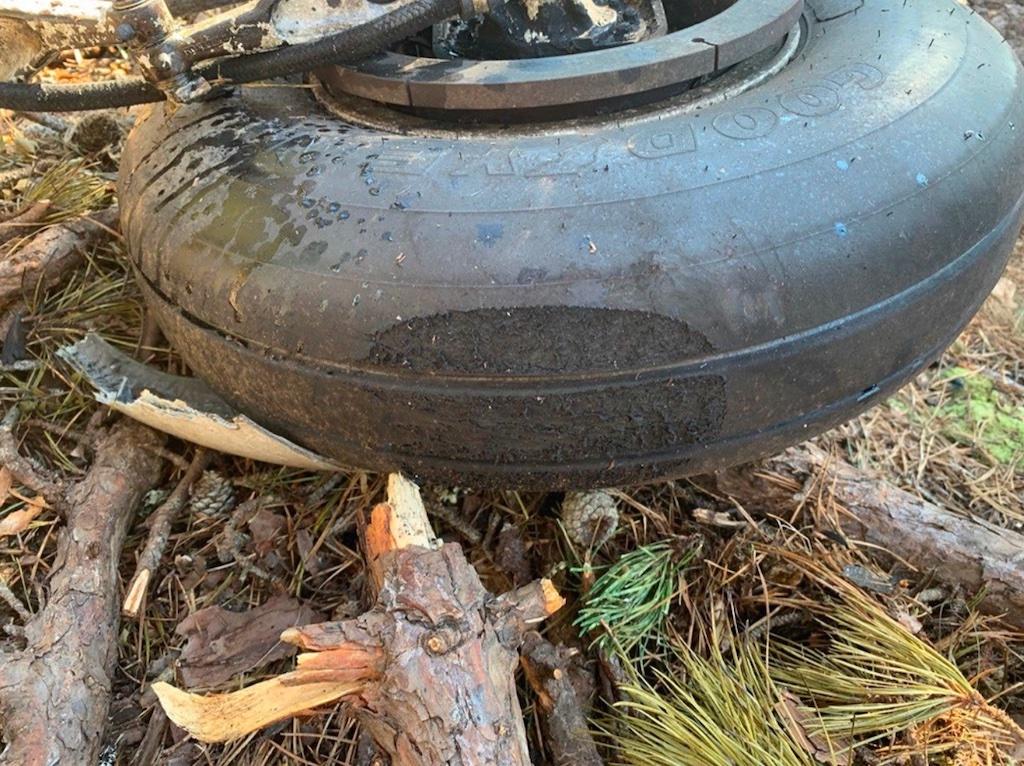
The right main landing gear tire showed areas of melted rubber.
Following the crash of Cape Air Flight 2072, safety investigators interviewed the two passengers who had been seated directly behind the pilot and co-pilot seats. One passenger said the landing “felt smooth,” with no bounce. She said the brakes came on, the airplane slowed down, and there was a second heavier application of the brakes when she could feel her body shift forward.
After the tail end of the airplane moved left-right-then left, the captain added full power. The second passenger said it was raining heavily, and the airplane skidded and “fishtailed.” She said the airplane never slowed down.
When the wreckage of the Cessna 402C was examined, the right main landing gear tire showed two oval-shaped areas of melted rubber. When the tire was later examined at the NTSB’s lab, the technician said the marks were consistent with multiple skid events.
The evidence from the passengers and the tire indicated that, contrary to his recollection, the pilot had first attempted to brake before commencing his go-around.
Examination of the wreckage showed the airplane came to rest about 200 ft. beyond the point of its initial impact with trees. The flap indicator was at zero and the right flap was fully retracted. The left flap was too damaged to be measured. The landing gear was down at the time of impact. The engines were damaged in the crash, but investigators found no mechanical defects in them.
The airplane had two doors and an emergency exit. The pilot’s door (crew door) was badly damaged. The emergency exit on the right side of the passenger compartment was open but had been too hot to use. The main door was a two-section, outward opening, airstair door on the left aft side. The top half was open, the bottom half closed. A 5-in. tree limb blocked the lower door half.
Provincetown Municipal Airport was not required to provide aircraft rescue and firefighting services under 14 CFR Part 139. It is a noncontrolled, publicly owned commercial service airport and has only a single asphalt runway. That runway is 3,502 ft. long by 100 ft. wide. Runway 7 is equipped with high-intensity runway edge lights, a medium intensity approach lighting system with sequenced flashers, and a 4-light precision approach path indicator (PAPI) system.
The 51-year-old pilot held an airline transport pilot certificate with a rating for airplane multiengine land. He was a certified flight instructor and had a current FAA first-class medical certificate. He had been employed by Cape Air for about nine years and reported a total of 17,617 flight hours, of which 10,000 hr. were in the Cessna 402C. He was also type rated in Boeing 727 and Beech 1900 airplanes.
The airplane was not equipped with a flight data or voice recorder. The absence of these recorders hampers investigators in many ways, but in this case, investigators were able to garner useful information from airport cameras, ADS-B data, and passenger statements.
The airplane’s altitude, position, and speed during its approach to Runway 7 was computed from ADS-B data. Surveillance videos showed the airplane during the landing roll and go-around, and this was used to determine the position and speed of the airplane along the runway. It was also used to determine the elapsed time between touchdown and impact with the trees.
A High And Fast Approach
An aircraft performance study showed the airplane was slightly outside company stabilized approach criteria but correcting during the last 1,000 ft. of its approach. It was a bit high and fast. As the airplane decelerated, it ballooned to a dot high on the ILS and the pilot then exceeded 1,000 fpm while descending to get down to the glide path.
In addition, the tailwind increased as the approach progressed. The tailwind component increased from 3-to-4 kts. to 11 kts. at the time of landing. The airplane touched down about 500 ft. from the Runway 7 threshold at about 104 kts. ground speed, 18 kts. faster than the Pilot Operating Handbook speed for that weight.
The pilot was apparently unaware that the tailwind exceeded 5 kts. as he approached the field. If he had realized that the tailwind was excessive, company policy would have required him to discontinue the approach. Automated Weather Observing System data for the last three minutes of the flight showed the tailwind component increased from 6 to 11 kts. during that time.
A video study was also done. Two cameras recorded the landing and midpoint areas of the runway. A third was aimed at the departure end of the runway and recorded the airplane’s collision with trees. Once the optics of the first two cameras were calibrated, a model of the airplane’s motion along the runway was constructed and its speed and deceleration were calculated.
The airplane touched down 6.1 sec. into the first video and lifted off 21 sec. later. During that time, it decelerated at 0.16 g, slowing to 57.2 kts. at a point 896 ft. from the end of the runway. The deceleration is about half the value normally achieved on a dry runway and is typical of wet runway landings.
NTSB engineers calculated that if the pilot had maintained the same level of deceleration while remaining on the ground, he would have stopped the airplane and it is likely there would have been no injuries, in Part 3 of this article.
Deciding Too Late To Go Around, Part 1: https://aviationweek.com/business-aviation/safety-ops-regulation/decidi…





